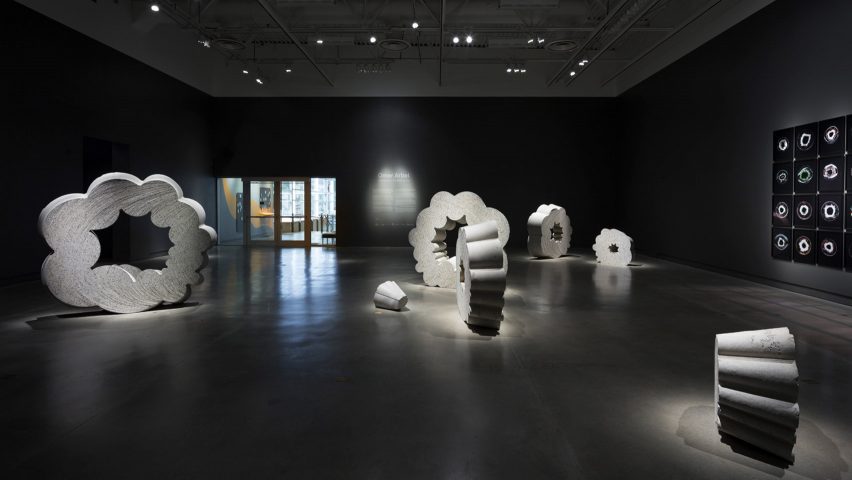Slices taken from a concrete column cast inside a flexible fabric mould form the centrepiece of this exhibition in Vancouver showcasing designer Omer Arbel's material experiments.
The installation at the Surrey Art Gallery focuses on Omer Arbel Office's artistic interrogation of concrete's physical properties.
It attempts to demonstrate potential new uses for a construction material that is typically defined by its solidity and permanence.
Arbel, who is creative director at Canadian manufacturing and design brand Bocci, is known for his creative approach to materials research. The exhibition presents several of his experiments, including the unusual concrete objects.
"My intention is to develop a way of working with concrete that acknowledges its liquid nature and yields expressive form," said the designer.
"These new methods could have significant practical and sculptural ramifications for the construction industry."
Dezeen's Marcus Fairs and Omer Arbel participated in a talk in Vancouver
The concrete objects exhibited at Particles for the Built World were created in a Vancouver warehouse, where Arbel also participated in a talk held on 7 May with Dezeen's editor in chief, Marcus Fairs.
During the conversation, the pair discussed Arbel's practice and various projects that span architecture, sculpture, invention and design. The designer also outlined why he wanted to delve deeper into our existing relationship with concrete.
"When we build things out of concrete, typically we build first out of wood," Arbel pointed out during his presentation of the project.
"My critique of this process is that it's not only very expensive, slow and labour intensive, it's also dishonest to the material because the fluidity and plasticity of concrete isn't in the least bit evident in the final piece that you see."
Arbel explained that the studio has spent years looking at new ways of working with concrete. It felt that casting the material in fabric moulds offered a promising opportunity to create shapes with potential to be used in architecture.
The process of experimentation began by pouring plaster into stretchy Lycra leggings and tights to explore the shapes it would produce. The concept was then scaled up and provided the basis for a participatory event that invited visitors to witness the production of the artwork.
Arbel created a structure in the warehouse by wrapping a series of plywood ribs in a sheet of tarpaulin-like geo-textile. The stretched fabric was filled with concrete and left to cure for 29 days before being sliced into sections using a diamond-rope saw.
Two separate events were held so visitors could view the pouring and cutting of the concrete, which transformed the creation of the objects into a performative artwork.
"When we made these pieces for the gallery it was the first time we invited an audience to be part of that making process," said Arbel. "So that moment when an abstract idea turning into a real object was shared with an audience is why I called those openings performances."
The concrete discs are arranged within Gallery 1 at Surrey Art Gallery, where visitors are able to examine the internal composition of the sliced column. The walls of this space also feature images depicting several of Arbel's other experiments with materials such as glass and copper mesh.
Particles for the Built World extends into Gallery 2, which contains a display outlining how the studio is applying the fabric-forming process on an architectural scale at a house that is currently under construction in South Surrey.
Nine of the reverse trumpet forms are installed within the house's living spaces, with each one accommodating the root ball of a mature tree.
Arbel suggested that the project was conceived as a way to celebrate the sculptural concrete forms, which are incorporated into the design "as if we encountered them for the first time on site".
The fluted concrete pillars contrast with the otherwise contemporary, clean-lined structure, which was erected around the sculptural elements in order to frame them and ensure they remain visible from both inside and outside.
During the talk with Dezeen, Arbel also described how material experimentation is integral to Bocci's creative process and many of the unique objects it creates. These include light fittings made from stretched loops of pearlescent glass and cloud-like pendant shades made by forcing molten glass into a heat-resistant fabric pillow.

